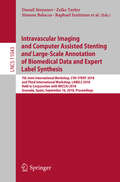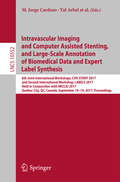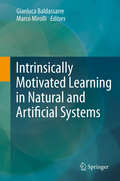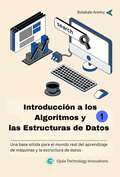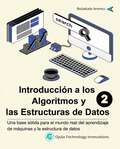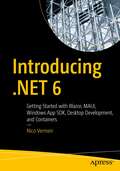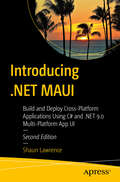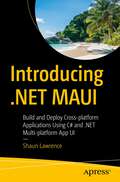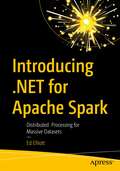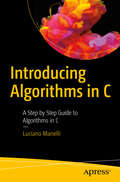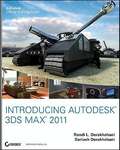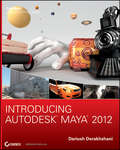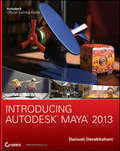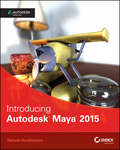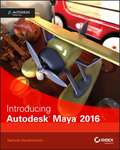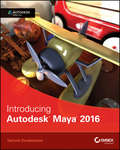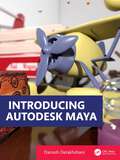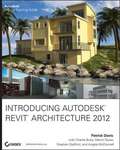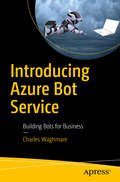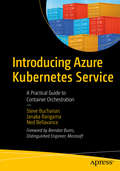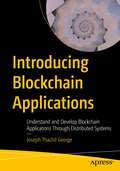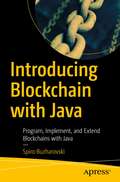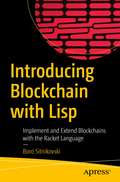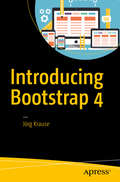- Table View
- List View
Intravascular Imaging and Computer Assisted Stenting and Large-Scale Annotation of Biomedical Data and Expert Label Synthesis: 7th Joint International Workshop, CVII-STENT 2018 and Third International Workshop, LABELS 2018, Held in Conjunction with MICCAI 2018, Granada, Spain, September 16, 2018, Proceedings (Lecture Notes in Computer Science #11043)
by Emanuele Trucco Eric Granger Pierre Jannin Su-Lin Lee Diana Mateus Lena Maier-Hein Veronika Cheplygina Simone Balocco Guillaume Zahnd Stefanie Demirci Luc Duong Shadi Albarqouni Danail Stoyanov Zeike Taylor Anne Martel Raphael Sznitman Stefano MoriconiThis book constitutes the refereed joint proceedings of the 7th Joint International Workshop on Computing and Visualization for Intravascular Imaging and Computer Assisted Stenting, CVII-STENT 2018, and the Third International Workshop on Large-Scale Annotation of Biomedical Data and Expert Label Synthesis, LABELS 2018, held in conjunction with the 21th International Conference on Medical Imaging and Computer-Assisted Intervention, MICCAI 2018, in Granada, Spain, in September 2018. The 9 full papers presented at CVII-STENT 2017 and the 12 full papers presented at LABELS 2017 were carefully reviewed and selected. The CVII-STENT papers feature the state of the art in imaging, treatment, and computer-assisted intervention in the field of endovascular interventions. The LABELS papers present a variety of approaches for dealing with few labels, from transfer learning to crowdsourcing.
Intravascular Imaging and Computer Assisted Stenting, and Large-Scale Annotation of Biomedical Data and Expert Label Synthesis
by Eric Granger Su-Lin Lee M. Jorge Cardoso Gustavo Carneiro Diana Mateus Tal Arbel Lena Maier-Hein Veronika Cheplygina Simone Balocco Guillaume Zahnd Stefanie Demirci Luc Duong Marc-André Carbonneau Shadi AlbarqouniThis book constitutes the refereed joint proceedings of the 6th Joint International Workshop on Computing and Visualization for Intravascular Imaging and Computer Assisted Stenting, CVII-STENT 2017, and the Second International Workshop on Large-Scale Annotation of Biomedical Data and Expert Label Synthesis, LABELS 2017, held in conjunction with the 20th International Conference on Medical Imaging and Computer-Assisted Intervention, MICCAI 2017, in Québec City, QC, Canada, in September 2017. The 6 full papers presented at CVII-STENT 2017 and the 11 full papers presented at LABELS 2017 were carefully reviewed and selected. The CVII-STENT papers feature the state of the art in imaging, treatment, and computer-assisted intervention in the field of endovascular interventions. The LABELS papers present a variety of approaches for dealing with few labels, from transfer learning to crowdsourcing.
Intrinsically Motivated Learning in Natural and Artificial Systems
by Marco Mirolli Gianluca BaldassarreIt has become clear to researchers in robotics and adaptive behaviour that current approaches are yielding systems with limited autonomy and capacity for self-improvement. To learn autonomously and in a cumulative fashion is one of the hallmarks of intelligence, and we know that higher mammals engage in exploratory activities that are not directed to pursue goals of immediate relevance for survival and reproduction but are instead driven by intrinsic motivations such as curiosity, interest in novel stimuli or surprising events, and interest in learning new behaviours. The adaptive value of such intrinsically motivated activities lies in the fact that they allow the cumulative acquisition of knowledge and skills that can be used later to accomplish fitness-enhancing goals. Intrinsic motivations continue during adulthood, and in humans they underlie lifelong learning, artistic creativity, and scientific discovery, while they are also the basis for processes that strongly affect human well-being, such as the sense of competence, self-determination, and self-esteem. This book has two aims: to present the state of the art in research on intrinsically motivated learning, and to identify the related scientific and technological open challenges and most promising research directions. The book introduces the concept of intrinsic motivation in artificial systems, reviews the relevant literature, offers insights from the neural and behavioural sciences, and presents novel tools for research. The book is organized into six parts: the chapters in Part I give general overviews on the concept of intrinsic motivations, their function, and possible mechanisms for implementing them; Parts II, III, and IV focus on three classes of intrinsic motivation mechanisms, those based on predictors, on novelty, and on competence; Part V discusses mechanisms that are complementary to intrinsic motivations; and Part VI introduces tools and experimental frameworks for investigating intrinsic motivations.The contributing authors are among the pioneers carrying out fundamental work on this topic, drawn from related disciplines such as artificial intelligence, robotics, artificial life, evolution, machine learning, developmental psychology, cognitive science, and neuroscience. The book will be of value to graduate students and academic researchers in these domains, and to engineers engaged with the design of autonomous, adaptive robots. The contributing authors are among the pioneers carrying out fundamental work on this topic, drawn from related disciplines such as artificial intelligence, robotics, artificial life, evolution, machine learning, developmental psychology, cognitive science, and neuroscience. The book will be of value to graduate students and academic researchers in these domains, and to engineers engaged with the design of autonomous, adaptive robots.
Intrinsically Motivated Learning in Natural and Artificial Systems
by Marco Mirolli Gianluca BaldassarreIt has become clear to researchers in robotics and adaptive behaviour that current approaches are yielding systems with limited autonomy and capacity for self-improvement. To learn autonomously and in a cumulative fashion is one of the hallmarks of intelligence, and we know that higher mammals engage in exploratory activities that are not directed to pursue goals of immediate relevance for survival and reproduction but are instead driven by intrinsic motivations such as curiosity, interest in novel stimuli or surprising events, and interest in learning new behaviours. The adaptive value of such intrinsically motivated activities lies in the fact that they allow the cumulative acquisition of knowledge and skills that can be used later to accomplish fitness-enhancing goals. Intrinsic motivations continue during adulthood, and in humans they underlie lifelong learning, artistic creativity, and scientific discovery, while they are also the basis for processes that strongly affect human well-being, such as the sense of competence, self-determination, and self-esteem.This book has two aims: to present the state of the art in research on intrinsically motivated learning, and to identify the related scientific and technological open challenges and most promising research directions. The book introduces the concept of intrinsic motivation in artificial systems, reviews the relevant literature, offers insights from the neural and behavioural sciences, and presents novel tools for research. The book is organized into six parts: the chapters in Part I give general overviews on the concept of intrinsic motivations, their function, and possible mechanisms for implementing them; Parts II, III, and IV focus on three classes of intrinsic motivation mechanisms, those based on predictors, on novelty, and on competence; Part V discusses mechanisms that are complementary to intrinsic motivations; and Part VI introduces tools and experimental frameworks for investigating intrinsic motivations.The contributing authors are among the pioneers carrying out fundamental work on this topic, drawn from related disciplines such as artificial intelligence, robotics, artificial life, evolution, machine learning, developmental psychology, cognitive science, and neuroscience. The book will be of value to graduate students and academic researchers in these domains, and to engineers engaged with the design of autonomous, adaptive robots.The contributing authors are among the pioneers carrying out fundamental work on this topic, drawn from related disciplines such as artificial intelligence, robotics, artificial life, evolution, machine learning, developmental psychology, cognitive science, and neuroscience. The book will be of value to graduate students and academic researchers in these domains, and to engineers engaged with the design of autonomous, adaptive robots.
Introducción a los Algoritmos y las Estructuras de Datos 1: Una base sólida para el mundo real del aprendizaje de máquinas y la estructura de datos (Introducción a los Algoritmos y las Estructuras de Datos #1)
by Bolakale AremuBeneficios acerca del aprendizaje de algoritmos y estructuras de datos. Primero, te ayudarán a convertirte en un mejor programador. Otro beneficio es que te harán pensar más lógicamente. Además, te pueden ayudar a diseñar mejores sistemas para almacenar y procesar datos. También sirven como una herramienta para la optimización y solución de problemas. Como resultado, los conceptos de algoritmos y estructuras de datos son muy valiosos en cualquier campo. Por ejemplo, puedes utilizarlos cuando construyas una aplicación web o escribes software para otros dispositivos. Puedes utilizarlos para aprendizaje de máquinas y analíticas de datos, las cuales son actualmente dos áreas excitantes. Si eres un hacker, los algoritmos y las estructuras de datos en Python también son importantes para ti en cualquier parte. Ahora, cualquiera que sea tu estilo de aprendizaje preferido, te tendré cubierto. Si eres un aprendiz visual, te encantarán mis diagramas claros e ilustraciones a través de este libro. Si eres un aprendiz práctico, te encantarán mis lecciones de práctica, de manera que puedas obtener práctica con algoritmos y estructuras de datos de una forma práctica. Estructura del curso. Hay cinco volúmenes en este curso. Este es el volumen uno. En este volumen, tomarás una inmersión profunda en el mundo de los algoritmos. Con frecuencia incremental, los algoritmos comienzan a moldear nuestras vidas de muchas maneras - desde los productos que nos recomiendan, hasta los amigos en que interactuamos en los medios sociales, y aún más importante que los aspectos sociales, como las políticas, privacía y cuidado de la salud. Por lo tanto, la primera parte de este curso cubre lo que son los algoritmos, como trabajan, donde se les puede encontrar (en aplicaciones de la vida real). En el segundo volumen, trabajarás a través de la introducción de las estructuras de datos. Aprenderás acerca de las e
Introducción a los Algoritmos y las Estructuras de Datos 2: Una base sólida para el mundo real del aprendizaje de máquinas y análisis de datos (Introducción a los Algoritmos y las Estructuras de Datos #2)
by Bolakale AremuIntroducción a Algoritmos y Estructuras de Datos - Volumen 2 Este libro es el segundo volumen de una serie titulada Introducción a los Algoritmos y Estructuras de Datos. El diseño de un algoritmo eficiente para la solución de problemas requiere la inclusión de las estructuras de datos apropiadas. En el campo de la ciencia de la computación, las estructuras de datos se utilizan para organizar y almacenar datos de una forma que sea más fácil de entender y utilizar. Se utilizan para organizar y representar datos de una forma que sea más fácil a las computadoras recuperar y analizar. Estos son los bloques de construcción fundamentales que cualquier programador debe conocer acerca de cómo utilizarlos correctamente para construir tus propios programas.
Introducing .NET 6: Getting Started with Blazor, MAUI, Windows App SDK, Desktop Development, and Containers
by Nico VermeirWelcome to .NET 6, Microsoft’s unified framework that converges the best of the modern and traditional .NET Framework. This book will introduce you to the new aspects of Microsoft’s fully supported .NET 6 Framework and will teach you how to get the most out of it. You will learn about the progress to one unified .NET, including MAUI and the revival of desktop development. You will dive into Roslyn, Blazor, CLI, Containers, Cloud, and much more, using a “framework first” learning approach. You will begin by learning what each tool is, its practical uses, and how to apply it and then you will try it out on your own for learning reinforcement. And, of course, there will be plenty of code samples using C# 10.Introducing .NET 6 is aimed at .NET developers, both junior developers and those coming from the .NET framework, who want to understand everything the modern framework has to offer, besides the obvious programming languages. While you will still see a lot of fabulous C# 10 throughout the book, the focus of this learning is all about .NET and its tooling.What You Will LearnBecome a more versatile developer by knowing the variety of options available to you in the .NET 6 framework and its powerful toolingKnow the different front-end frameworks .NET offers, such as UWP, WPF, and WinForms, and how they stack up to each otherUnderstand the different communication protocols, such as REST and gRPC, for your back-end servicesDiscover the secrets of cloud-native development, such as serverless computing with Azure Functions and deploying containers to Azure Container ServicesMaster the command line, take your skill set to the cloud, and containerize your .NET 6 app Who This Book Is ForBoth students and more experienced developers, C# developers who want to learn more about the framework they use, developers who want to be more productive by diving deeper into the tooling that .NET 6 brings to the fold, developers who need to make technical decisions. A working knowledge of C# is recommended to follow the examples used in the book.
Introducing .NET MAUI: Build and Deploy Cross-Platform Applications Using C# and .NET 9.0 Multi-Platform App UI
by Shaun LawrenceInterested in giving Microsoft’s new Multi-platform App UI (MAUI) a try? This book provides developers with a comprehensive set of tools and hands-on coding to build their own cross-platform applications. The book is a comprehensive end-to-end guide on creating, building, and distributing .NET MAUI applications. As you walk through each new concept, .NET MAUI expert and Microsoft MVP Shaun Lawrence will show the concept's value and uses, and then have you apply it in a build-along application. You will work with this build-along application right up until you are ready to ship it to the relevant stores (e.g., App Store, etc.). The underlying theme through the book is to explain a key concept, show how to implement it directly in order to reinforce your understanding, and then show potential simplifications (e.g., alternative libraries) that can help you reduce the complexities of an applications code base. What You Will Learn Create a .NET MAUI application Apply commonly required techniques Apply more advanced techniques to make applications stand out Know what to consider when distributing applications to the relevant stores Take an application from concept through to production Who This Book Is For Developers who are new to .NET MAUI and cross-platform development. A basic knowledge of C# is required, but no prior knowledge using .NET MAUI is required. Experienced developers also will find the book useful as it covers topics key to modern day development (such as accessibility, performance, and distribution). Xamarin Forms developers will find the book useful as key features new to .NET MAUI that will aid in the migration from Xamarin Forms to .NET MAUI are explained. New To This Edition Gain insights on the latest updates to .NET MAUI with the release of version 9.0. Learn about features like AOT, Polly, MauiReactor, Shell, and more.
Introducing .NET MAUI: Build and Deploy Cross-platform Applications Using C# and .NET Multi-platform App UI
by Shaun LawrenceInterested in giving Microsoft’s new Multi-platform App UI (MAUI) a try? This book provides developers with a comprehensive set of tools and hands-on coding to build their own cross-platform applications.The book is a comprehensive end-to-end guide on creating, building, and distributing .NET MAUI applications. As you walk through each new concept, .NET MAUI expert and Microsoft MVP Shaun Lawrence will show the concept's value and uses, and then have you apply it in a build-along application. You will work with this build-along application right up until you are ready to ship it to the relevant stores (e.g., App Store, etc.). The underlying theme through the book is to explain a key concept, show how to implement it directly in order to reinforce your understanding, and then show potential simplifications (e.g., alternative libraries) that can help you reduce the complexities of an applications code base. What You Will LearnCreate a .NET MAUI applicationApply commonly required techniquesApply more advanced techniques to make applications stand outKnow what to consider when distributing applications to the relevant storesTake an application from concept through to production Who This Book Is ForDevelopers who are new to .NET MAUI and cross-platform development. A basic knowledge of C# is required, but no prior knowledge using .NET MAUI is required. Experienced developers also will find the book useful as it covers topics key to modern day development (such as accessibility, performance, and distribution). Xamarin Forms developers will find the book useful as key features new to .NET MAUI that will aid in the migration from Xamarin Forms to .NET MAUI are explained.
Introducing .NET for Apache Spark: Distributed Processing for Massive Datasets
by Ed ElliottGet started using Apache Spark via C# or F# and the .NET for Apache Spark bindings. This book is an introduction to both Apache Spark and the .NET bindings. Readers new to Apache Spark will get up to speed quickly using Spark for data processing tasks performed against large and very large datasets. You will learn how to combine your knowledge of .NET with Apache Spark to bring massive computing power to bear by distributed processing of extremely large datasets across multiple servers.This book covers how to get a local instance of Apache Spark running on your developer machine and shows you how to create your first .NET program that uses the Microsoft .NET bindings for Apache Spark. Techniques shown in the book allow you to use Apache Spark to distribute your data processing tasks over multiple compute nodes. You will learn to process data using both batch mode and streaming mode so you can make the right choice depending on whether you are processing an existing dataset or are working against new records in micro-batches as they arrive. The goal of the book is leave you comfortable in bringing the power of Apache Spark to your favorite .NET language. What You Will LearnInstall and configure Spark .NET on Windows, Linux, and macOS Write Apache Spark programs in C# and F# using the .NET bindingsAccess and invoke the Apache Spark APIs from .NET with the same high performance as Python, Scala, and REncapsulate functionality in user-defined functionsTransform and aggregate large datasets Execute SQL queries against files through Apache HiveDistribute processing of large datasets across multiple serversCreate your own batch, streaming, and machine learning programsWho This Book Is For.NET developers who want to perform big data processing without having to migrate to Python, Scala, or R; and Apache Spark developers who want to run natively on .NET and take advantage of the C# and F# ecosystems
Introducing Algorithms in C: A Step by Step Guide to Algorithms in C
by Luciano ManelliStudy elementary and complex algorithms with clear examples and implementations in C. This book introduces data types (simple and structured) and algorithms with graphical and textual explanations. In the next sections, you’ll cover simple and complex standard algorithms with their flowcharts: everything is integrated with explanations and tables to give a step-by-step evolution of the algorithms. The main algorithms are: the sum of three or n numbers in a loop, decimal-to-binary conversion, maximum and minimum search, linear/sequential search, binary search, bubble sort, selection sort, merging of two sorted arrays, reading characters from a file, stack management, and factorial and Fibonacci sequences. The last section of Introducing Algorithms in C is devoted to the introduction of the C language and the implementation of the code, which is connected to the studied algorithms. The book is full of screenshots and illustrations showing the meaning of the code. What You Will Learn Implement algorithms in C Work with variables, constants, and primitive and structured types Use arrays, stacks, queues, graphs, trees, hash tables, records, and files Explore the design of algorithms Solve searching problems, including binary search, sorting, and bubble/selection sort Program recursive algorithms with factorial functions and Fibonacci sequences Who This Book Is For Primarily beginners: it can serve as a starting point for anyone who is beginning the study of computer science and information systems for the first time.
Introducing Autodesk 3ds Max 2011
by Dariush DerakhshaniAn Autodesk Official Training Guide to 3ds Max 2011 3ds Max is a popular 3D animation-and-effects software used in movies, visual effects, games, cartoons, short films, commercials, and other animation. However, it also presents a number of challenges to newcomers. This introduction to the latest version breaks down the complexities of learning 3D software and walks you through the basics of modeling, texturing, animating, and using visual effects. Real-world examples from talented beginning 3ds max users motivate you to learn the software and helpful tutorials offer realistic, professional challenges for you to unravel. In addition, each chapter is richly illustrated with workflows to make learning 3ds max 2011 much easier and fn. Introduces you to the basics of modeling, texturing, animating, and incorporating visual effects using the latest version of 3ds Max software Features excellent tutorials, helpful examples, detailed workflows, and a companion Web site to enhance your learning experience Explains a variety of methods for solving real-world challenges and breaks down why certain methods are used Makes the transition of coming from other 3D software applications as smooth as possible Introducing 3ds Max 2011 takes a typically difficult subject and breaks into easily digestible pieces so you can confidently begin working with this 3D animation software today.
Introducing Autodesk Maya 2012
by Dariush DerakhshaniA practical, step-by-step guide to Maya 2012 This book is the ideal primer to getting started with Maya, the premier 3D animation and effects software used in movies, visual effects, games, cartoons, short films, and commercials. You'll learn the Maya interface and the basics of modeling, texturing, animating, and visual effects. Professional visual effects artist and instructor Dariush Derakhshani explains the nuances of the complex software, while creative tutorials offer realistic, professional challenges for those new to 3D. You'll be up and running in no time with the world's most popular professional 3D software application. Provides a thorough, step-by-step introduction to Maya 2012 Explains the core concepts of CG and working in 3D Covers modeling, rigging, HDRI lighting, mental ray rendering, and more Concepts are reinforced with tutorials that offer realistic challenges and clear explanations Color insert provides real-world examples from talented beginning Maya users Build your Maya and animation skills from the ground up with this practical, thorough guide.
Introducing Autodesk Maya 2013
by Dariush DerakhshaniA complete update to the popular Autodesk Official Training Guide for Maya Maya is the industry-leading 3D animation and effects software used in movies, visual effects, games, cartoons, and other animation. This bestselling, official guide is a must for 3D beginners who want a thorough grounding in this dynamic and complex software. Fully updated for the newest version of Maya, the book explains the interface and the basics of modeling, texturing, animating, dynamics, visualization, and visual effects. Fun and challenging tutorials lead you through the nuances of the software and offer plenty of chances to practice what you've learned. The Autodesk Official Training Guide for Maya, endorsed and promoted by Autodesk to its 2,500 Authorized Training Centers worldwide Maya is the 3D animation and effects software used in the film, game, and advertising industries; it's a complex program and this book gives beginners the knowledge and confidence they need Shows how to master the interface and the basics of modeling, texturing, animating, and visual effects Step-by-step tutorials offer realistic, professional challenges for those new to 3D and those switching from another 3D application Materials are available for instructors who want to use this guide with their students Introducing Autodesk Maya is the perfect guide to get you up and running on the world's most popular professional 3D application.
Introducing Autodesk Maya 2015
by Dariush DerakhshaniLearn Autodesk Maya from an award-winning insider <P><P> Best-selling author, visual effects supervisor, and technical educator Dariush Derakhshani brings you a newly-updated, step-by-step guide to the most popular and complex 3D application on the market, Autodesk Maya. Introducing Autodesk Maya 2015 includes straightforward lessons, real-world examples, detailed tutorials, and downloadable project files that get you modeling and animating your own digital models and scenes right away.<P> The book starts you with the latest CG concepts and production workflows, and then shows you how to create a solar system to help get you acquainted with the basic tool set in Maya. From there, the books helps you: <P> * Learn the Maya user interface, including menus and plug-ins <P> * Build simple animations and 3D images right away <P> * Explore polygons, modeling, and NEX tools<P> * Get started with HDRI lighting, rendering, dynamics, simulations, and effects <P> Whether you're new to 3D or migrating from another 3D application, Introducing Autodesk Maya 2015 will kick-start your creativity and get you up and running with Maya. Author Derakhshani has worked on movies such as The Fantastic Four and Pan's Labyrinth, the South Park TV series, and numerous commercials and music videos.
Introducing Autodesk Maya 2016: Autodesk Official Press
by Dariush DerakhshaniStart modeling right away with this hands-on guide to learning Autodesk Maya 2016 Introducing Autodesk Maya 2016 is the official guide to the most popular and complex 3D application on the market. Building from the ground up, this book combines straightforward text with practical examples that make it easy to absorb the basics and start designing and animating your own digital models and scenes. The tutorials offer realistic challenges and clear explanations, laid out in fun, step-by-step lessons that help you gain confidence and learn by doing. You'll delve into CG and 3D core concepts and production workflows, then get right to work designing an animation of the solar system as you learn the interface and basic tools. As your modeling skills grow, you'll build a steam locomotive, a starfish, a table lamp, and much more as you learn to rig your model for animation, create fabric motion with nCloth, and add the lighting and effects that bring your scenes to life. The companion website features downloadable project files that help you see how the pros do it, and the book includes real-world examples from talented users who were beginners just like you. Master the Maya 2016 interface, menus, and plug-ins Begin building simple animations right away Explore modeling, rendering, animation, and cloth motion Add lighting, rendering, dynamics, simulations, and effects If you want to work like the pros, Introducing Autodesk Maya 2016 is the perfect primer for getting started.
Introducing Autodesk Maya 2016: Autodesk Official Press
by Dariush DerakhshaniStart modeling right away with this hands-on guide to learning Autodesk Maya 2016 Introducing Autodesk Maya 2016 is the official guide to the most popular and complex 3D application on the market. Building from the ground up, this book combines straightforward text with practical examples that make it easy to absorb the basics and start designing and animating your own digital models and scenes. The tutorials offer realistic challenges and clear explanations, laid out in fun, step-by-step lessons that help you gain confidence and learn by doing. You'll delve into CG and 3D core concepts and production workflows, then get right to work designing an animation of the solar system as you learn the interface and basic tools. As your modeling skills grow, you'll build a steam locomotive, a starfish, a table lamp, and much more as you learn to rig your model for animation, create fabric motion with nCloth, and add the lighting and effects that bring your scenes to life. The companion website features downloadable project files that help you see how the pros do it, and the book includes real-world examples from talented users who were beginners just like you. Master the Maya 2016 interface, menus, and plug-ins Begin building simple animations right away Explore modeling, rendering, animation, and cloth motion Add lighting, rendering, dynamics, simulations, and effects If you want to work like the pros, Introducing Autodesk Maya 2016 is the perfect primer for getting started.
Introducing Autodesk Maya: Autodesk Official Press
by Dariush DerakhshaniThis book is your perfect hands‑on guide to start animating quickly. Using approachable, real‑world exercises, you’ll master the fundamentals of this animation software by following full‑color screenshots step by step. Each chapter opens with a quick discussion of concepts and learning objectives, and then launches into hands‑on tutorials that give you firsthand experience and a good start. You’ll learn the basics of modeling, texturing, animating, and visual effects. Whether you’re a complete beginner or migrating from another 3D application, this task‑based book provides the solid grounding you need in Autodesk Maya.Key Features Model with polygons, meshes, and more Add motion with simple and complex animations Add color and textures to visualize materials and surfaces Render scenes with great lighting and camera placement
Introducing Autodesk Revit Architecture 2012
by Patrick DavisA fast, focused introduction to Revit functions, tools, and concepts As the leading Building Information Modeling software package, Revit is praised for its ease of use, power, and sophistication. Authored by a high profile team of Revit professionals, this reference and tutorial quickly has readers building skills to an intermediate level by exploring Revit tools and tasks, putting parametric modeling to use, detailing the basics of views and constraints, and working with detailing, massing, rendering, interior design, and more. Based on real-world workflows and projects, this book shows you readers how to model, document, present, and share designs using Revit just the way the pros do. Discussions and workflows are reinforced with tutorials drawn from the authors' extensive experience, and a beautiful 16-page color insert focuses on real-world Revit projects. Helps novice-to-intermediate level users learn Revit and its functions, tools, and concepts easily and efficiently Contains straightforward explanations, real-world examples, beautiful illustrations, and practical tutorials that focus intently on accomplishing vital Revit tasks Features in-depth discussions reinforced by comprehensive step-by-step exercises that show you how to model, document, present, and share your designs Includes a beautiful 16-page color insert with inspirational and instructional images drawn from the authors' professional experience This book is the perfect resource for readers of all skill levels who want to quickly accomplish crucial Revit tasks.
Introducing Azure Bot Service: Building Bots for Business
by Charles WaghmareSee how custom chatbots and Azure Bot Service can resolve common business problems. This book takes you through the many possibilities of bot development from a business point of view, using Microsoft bot technology, and demonstrates how to connect, deploy, and manage them.Starting with an introduction to chatbots and their features you will go through the design and implementation of Azure chatbots. This will set the foundation for the rest of the book before you learn how to create and manage messages in chatbots. You’ll then see how to deploy your chatbot in different business scenarios and how to integrate Azure chatbots with different applications such as Facebook and Twitter. To really allow you to demonstrate business value, Introducing Azure Bot Service covers tips on enhancing customer satisfaction and developing insights by analyzing customer behavior. This knowledge will help you understand how artificial intelligence techniques such as chatbots help your organization undergo digital transformation.After reading this book, you will be ready to build chatbots using Microsoft Azure, deploy them in different business scenarios, and measure the benefits of chatbots. What You Will LearnBuild time-saving chatbots using Azure Bot ServiceEngage in proactive customer interaction Integrate chatbots as a key aspect of your business strategyImprove customer satisfactionEase into digital transformation using Azure chatbots Who This Book Is ForDevelopers who are interested in building chatbots.
Introducing Azure Kubernetes Service: A Practical Guide to Container Orchestration
by Steve Buchanan Janaka Rangama Ned BellavanceGo from zero to sixty deploying and running a Kubernetes cluster on Microsoft Azure! This hands-on practical guide to Microsoft’s Azure Kubernetes Service (AKS), a managed container orchestration platform, arms you with the tools and knowledge you need to easily deploy and operate on this complex platform. Take a journey inside Docker containers, container registries, Kubernetes architecture, Kubernetes components, and core Kubectl commands. Drawing on hard-earned experience in the field, the authors provide just enough theory to help you grasp important concepts, teaching the practical straightforward knowledge you need to start running your own AKS cluster. You will dive into topics related to the deployment and operation of AKS, including Rancher for management, security, networking, storage, monitoring, backup, scaling, identity, package management with HELM, and AKS in CI/CD. What You Will Learn Develop core knowledge of Docker containers, registries, and KubernetesGain AKS skills for Microsoft’s fastest growing services in the cloud Understand the pros and cons of deploying and operating AKSDeploy and manage applications on the AKS platform Use AKS within a DevOps CI/CD process Who This Book Is For IT professionals who work with DevOps, the cloud, Docker, networking, storage, Linux, or Windows. Experience with cloud, DevOps, Docker, or application development is helpful.
Introducing Blockchain Applications: Understand and Develop Blockchain Applications Through Distributed Systems
by Joseph Thachil GeorgeDeepen your understanding of blockchain technology and develop your own blockchain applications. This book provides a thorough review of distribution-based systems on blockchain technology, starting from the fundamental concepts that underlie it, all the way through the implementation of a blockchain network for business purposes. Author Joseph Thachil George begins by introducing you to blockchain and some basic concepts of technology, including distributed systems, systems of systems, cyber-physical systems, the Byzantine Consensus, the CAP theorem, and cryptographic techniques. Next, he analyzes the structure of blocks and smart contracts and the mother of all blockchain platforms, Bitcoin. That sets the stage for an examination of transaction structure, validation, and flow, from creation to registration in the ledger and structure of the blocks, the Nakamoto consensus, and finally forks. From there, you’ll experience a deep dive into Ethereum; including the concepts of Gas and Message, smart contracts and the Ethereum virtual machine. From there, you’ll learn about the Ethereum consensus protocol, Ethereum Casper, and the Ethereum Proof-of-Stake algorithm. You’ll then see how blockchain can be connected to a distributed system, followed by a demonstration of how you can model a distributed system using Blockly4SoS and Kilobots. The concluding chapters offer a practical example that combines distributed systems with blockchain technology. After reading this book, you will understand how to implement blockchain technology in a distributed system and be able to leverage this knowledge in your own projects. What You Will Learn Learn the concept of blockchains by way of a practical example Grasp the connection between distributed systems and blockchain technologyLearn the design of blockchain with hyperledger fabricLearn the design of cyber-physical systems in a distributed environment Who Is This Book For Developers who are enthusiastic about the design and implementation of distributed systems.
Introducing Blockchain with Java: Program, Implement, and Extend Blockchains with Java
by Spiro BuzharovskiCreate your own crypto currency by implementing blockchain technology using Java. This step-by-step guide will teach you how to create a user interface using Java FX and implement SQLite DB using JDBC Driver for the blockchain.Introducing Blockchain with Java includes numerous exercises and test questions to help you solidify what you have learned as you progress through the book, and provides ideas on expanding the codebase to make it your own. You will have access to a fully-functioning repository with Java code. Upon completing this book, you will have the knowledge necessary to program your own blockchains with Java and you will have a completed project for your portfolio. What You Will LearnKnow the most important theoretical concepts of the blockchainCode the blockchain in JavaCreate a user interface with JavaFXImplement SQLite DB using JDBC DriverCreate a P2P multi-threaded app Create your own cryptocurrency app with full functionalityImplement blockchain technology on a P2P network from scratch using Java, JavaFX, and SQLWho This Book Is ForAnyone with a basic level knowledge of: Java or similar object-oriented programming language, FXML or HTML or similar markup language, and SQL
Introducing Blockchain with Lisp: Implement and Extend Blockchains with the Racket Language
by Boro SitnikovskiImplement blockchain from scratch covering all the details with Racket, a general-purpose Lisp. You'll start by exploring what a blockchain is, so you have a solid foundation for the rest of the book. You'll then be ready to learn Racket before starting on your blockchain implementation. Once you have a working blockchain, you'll move onto extending it. The book's appendices provide supporting resources to help you in your blockchain projects. The recommended approach for the book is to follow along and write the code as it’s being explained instead of reading passively. This way you will get the most out of it. All of the source code is available for free download from GitHub. What You Will LearnDiscover the Racket programming language and how to use itImplement a blockchain from scratch using LispImplement smart contracts and peer-to-peer supportLearn how to use macros to employ more general abstractionsWho This Book Is For Novices that have at least some experience with programming, as well as some basic working experience with computers. The book also assumes some experience with high school mathematics, such as functions.
Introducing Bootstrap 4
by Jörg KrauseLearn how to use the front end CSS framework Bootstrap 4 to create powerful web applications. You'll work with all the components of Bootstrap 4 using easy-to-follow instructions and example code snippets. You'll also use Bootstrap 4 for typography, forms, and modules, and see how to structure your page and your code to be optimally efficient.CSS frameworks give front end developers the capability to create responsible or adaptive web designs that overcome the various variations of modern browsers. Bootstrap is the leading CSS framework and gives developers a unique way to create responsive web sites.What You'll LearnUnderstand the basics about responsive web design using CSS3Install and use the SASS frameworkUse the templates and themes market for BootstrapWho This Book Is ForThis book is for developers of web applications who already know how to use CSS and JavaScript and want to explore the capabilities of a framework to increase productivity.
